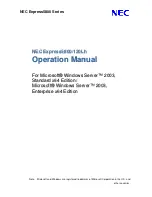
4
On the
System BIOS
screen, click
Processor Settings
.
Related link
Processor Settings
Processor Settings details
Processor Settings details
The
Processor Settings
screen details are explained as follows:
Option
Description
Logical Processor
Enables or disables the logical processors and displays the number of logical processors. If this option is set to
Enabled
, the BIOS displays all the logical processors. If this option is set to
Disabled
, the BIOS displays only one
logical processor per core. This option is set to
Enabled
by default.
QPI Speed
Enables you to control QuickPath Interconnect data rate settings.
Alternate RTID
(Requestor
Transaction ID)
Setting
Modifies Requestor Transaction IDs, which are QPI resources. This option is set to
Disabled
by default.
NOTE:
Enabling this option may negatively impact the overall system performance.
Virtualization
Technology
Enables or disables the additional hardware capabilities provided for virtualization. This option is set to
Enabled
by
default.
Address Translation
Service (ATS)
Defines the Address Translation Cache (ATC) for devices to cache the DMA transactions. This option provides an
interface between CPU and DMA Memory Management to a chipset's Address Translation and Protection Table to
translate DMA addresses to host addresses. This option is set to
Enabled
by default.
Adjacent Cache
Line Prefetch
Optimizes the system for applications that need high utilization of sequential memory access. This option is set to
Enabled
by default. You can disable this option for applications that need high utilization of random memory
access.
Hardware
Prefetcher
Enables or disables the hardware prefetcher. This option is set to
Enabled
by default.
DCU Streamer
Prefetcher
Enables or disables the Data Cache Unit (DCU) streamer prefetcher. This option is set to
Enabled
by default.
DCU IP Prefetcher
Enables or disables the Data Cache Unit (DCU) IP prefetcher. This option is set to
Enabled
by default.
Execute Disable
Enables you to run the disable memory protection technology. This option is set to
Enabled
by default.
Logical Processor
Idling
Enables you to improve the energy efficiency of a system. It uses the operating system core parking algorithm and
parks some of the logical processors in the system which in turn allows the corresponding processor cores to
transition into a lower power idle state. This option can only be enabled if the operating system supports it. It is set
to
Disabled
by default.
Configurable TDP
Enables you to reconfigure the processor Thermal Design Power (TDP) levels during POST based on the power
and thermal delivery capabilities of the system. TDP verifies the maximum heat the cooling system is needed to
dissipate. This option is set to
Nominal
by default.
NOTE:
This option is only available on certain stock keeping units (SKUs) of the processors.
X2Apic Mode
Enables or disables the X2Apic mode.
Number of Cores
per Processor
Controls the number of enabled cores in each processor. This option is set to
All
by default.
Processor 64-bit
Support
Specifies if the processor(s) support 64-bit extensions.
Processor Core
Speed
Specifies the maximum core frequency of the processor.
Process Bus Speed
Displays the bus speed of the processor.
48
Pre-operating system management applications
















































